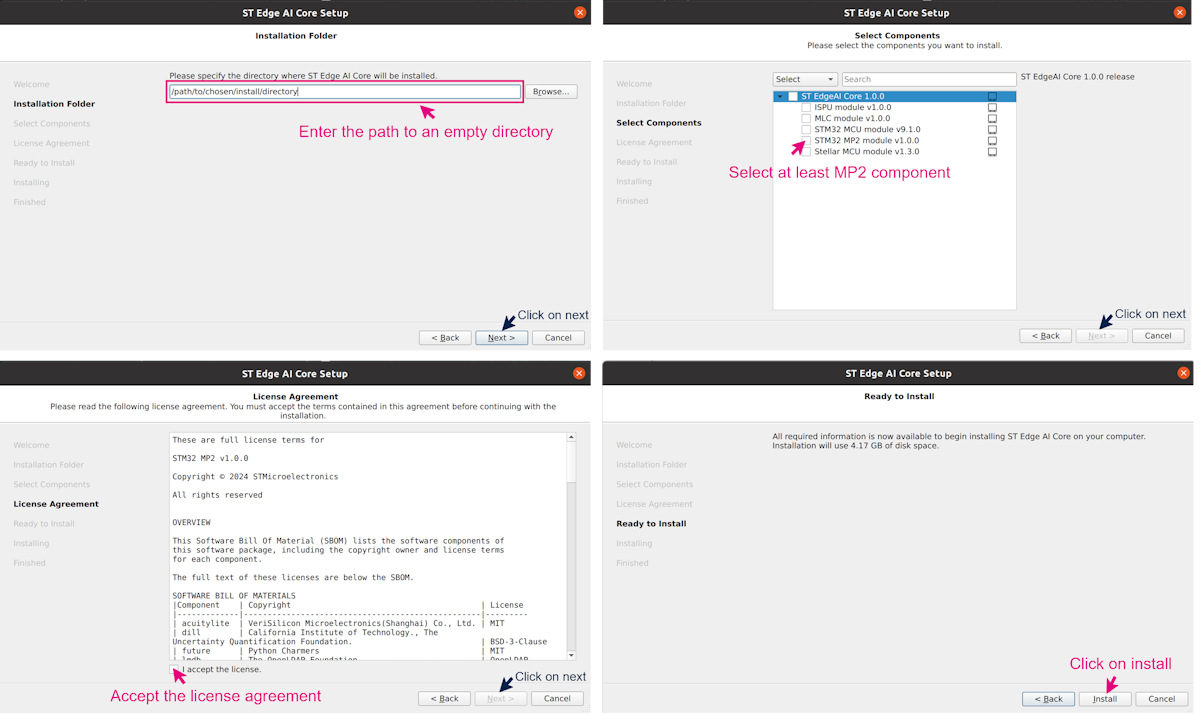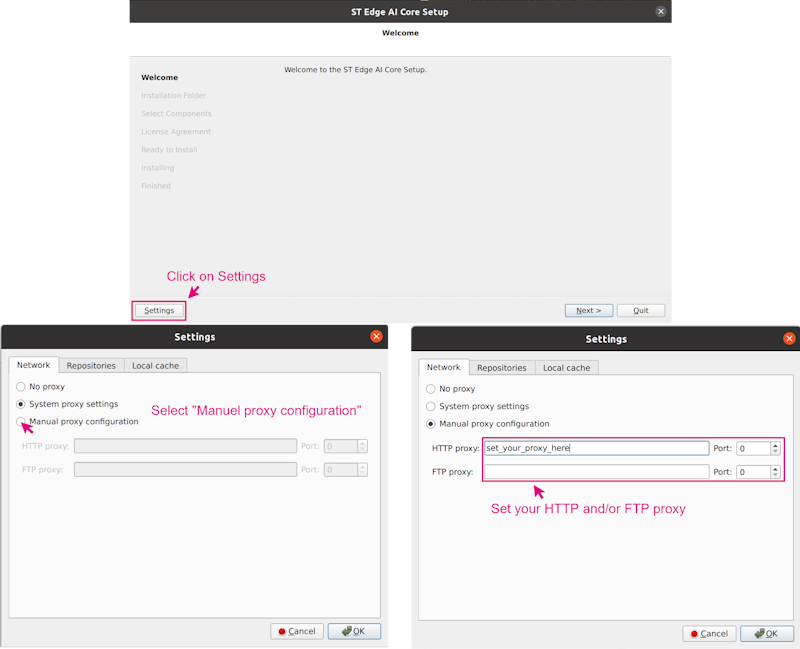1. Description[edit source]
1.1. What is ST Edge AI?[edit source]
The ST Edge AI utility provides a complete and unified Command Line Interface (CLI) to generate, from a pre-trained Neural Network (NN), an optimized model or a library for all STM32 devices including MPU, MCU, ISPU and MSC. It consists on three main commands: analyze, generate and validate. Each command can be used, regardless of the other commands using the same set of common options (model files, output directory…), or any specific options.
In the case of the STM32MPU, you can use the generate command in the ST Edge AI to convert a Neural Network (NN) model to an optimized Network Binary Graph (NBG). This NBG is the only format that allows you to run an NN model using the STM32MP2x Neural Processing Unit (NPU) acceleration.
1.2. Main features[edit source]
ST Edge AI is delivered as an archive containing an installer that can be executed to install the tool on the computer. This installer offers the possibility to select the ST Edge AI component to install. Some of these components are not available on all operating systems. In the case of the STM32MP2 component, it is available only for Linux.
The tool already contains all the python environment required to run a conversion. The objective is to allow the user to convert and execute a NN model easily on the STM32MP2x platforms. For this, the tool allows the conversion of a quantized TensorFlow™ Lite[1] or ONNX™[2] model into a NBG format.
The Network binary graph (NBG) is the precompiled NN model format using the OpenVX™ graph representation. This is the only NN format that can be loaded and executed directly on the NPU of STM32MP2x boards.
The model provided to the tool must be quantized using the 8-bits per-tensor asymmetric quantization scheme to have the best performances. If the quantization scheme is 8-bits per-channel, the model mainly runs on GPU, instead of NPU.
The tool does not support the custom operators:
If the provided model contains custom operations, these are automatically removed or the generation fails.
If the output of the model is already post-processed using a custom operator such as TFLite post-process, the post-processing layer is deleted. To prevent this situation:
- Provide a model that does not include the custom post-process layer, and code the post-process function inside your applications. The model runs on NPU, and the post-process is executed on CPU.
- Split your model to execute the core of the model on the NPU, using the NBG model and the post-processing layer on the CPU using your TensorFlow™ Lite or ONNX™ model with stai_mpu API.
Once this NBG is generated, you can benchmark or develop your AI application. For further information, refer to the following articles presenting how to deploy your NN model and guide to benchmark your NN model.
2. Installation[edit source]
Download the ST Edge AI tool here: https://www.st.com/en/development-tools/stedgeai-core.html
Then follow the step by step procedure to install the tool:
If you need to setup specific proxy settings, please follow the step by step procedure to setup the proxy:
The maintenancetool is an executable file located in your installation folder. When launched, it allows to add or remove a component, update an existing component (if an update is available), and uninstall the ST Edge AI tool.
3. How to use the tool[edit source]
3.1. Script utilization[edit source]
The main tool interface is the stedgeai binary. First, go to the binary directory:
cd <your_installation_path>/1.0/Utilities/linux
To print the target specific help, use:
./stedgeai --target stm32mp25 --help
The features of the stedgeai binary for the stm32mp25 target are the following:
usage: stedgeai --model FILE --target stm32|stellar-e|ispu|mlc [--workspace DIR] [--output DIR] [--no-report] [--no-workspace] [-h] [--version]
[--tools-version] [--verbosity [0|1|2|3]] [--quiet]
generate
ST Edge AI Core v1.0.0-19895 (STM32 MP2 module v1.0.0)
command:
generate must be the first argument (default: analyze)
analyze
check if the model is supported and get information about the model
architecture and memory footprint to know if the generated code can be
deployed on the target device
generate
generate the converted model for the target device
common options:
--model FILE, -m FILE
paths of the original model files
--target stm32|stellar-e|ispu|mlc
target/device selector
--workspace DIR, -w DIR
workspace folder to use (default: st_ai_ws)
--output DIR, -o DIR folder where the generated files are saved (default: st_ai_output)
additional options:
--no-report do not generate the report file
--no-workspace do not create the workspace folder
-h, --help show this help message and exit (use --target to get target specific help)
--version print the version of the tool
--tools-version print the versions of the third party packages used by the tool
--verbosity [0|1|2|3], -v [0|1|2|3], --verbose [0|1|2|3]
set verbosity level
--quiet disable the progress-bar
3.2. Testing with examples[edit source]
To generate a NBG model, you need to provide a quantized TensorFlow™ Lite or ONNX™ model, and select the correct target: stm32mp25.
3.2.1. Generate NBG from TensorFlow™ Lite or ONNX™[edit source]
To convert a TensorFlow™ Lite model to NBG:
./stedgeai generate -m path/to/tflite/model --target stm32mp25
To convert an ONNX™ model to NBG:
./stedgeai generate -m path/to/onnx/model --target stm32mp25
This command generates two files: the .nb file, which is the NBG model, and a .txt file, which is the report of the generate command.
- The .nb file is located in the output path specified by the --output option. Else by default, the .nb file is located in the st_ai_output default directory.
- The report (with the extension report_modelName_stm32mp25.txt) is located in the workspace folder specified by the --workspace option. Else by default, the report is located in the st_ai_ws default directory.
3.2.2. Generate NBG from TensorFlow™ Lite or ONNX™ without report[edit source]
To generate a NBG model without the report, add the --no-report option in your command line.
To convert a TensorFlow™ Lite model to NBG without the report:
./stedgeai generate -m path/to/tflite/model --target stm32mp25 --no-report
To convert an ONNX™ model to NBG without the report:
./stedgeai generate -m path/to/onnx/model --target stm32mp25 --no-report
This command generates a .nb file located in the output folder. If you use the option --output to specify a directory, the NBG is located inside, else the default output folder is st_ai_output.
4. References[edit source]

